Nanotechnologies in Construction: A Scientific Internet-Journal @nanobuild-en
Статьи журнала - Nanotechnologies in Construction: A Scientific Internet-Journal
Все статьи: 572
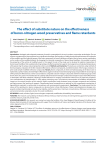
Статья научная
Introduction. Antiseptic and antipyretic treatment of wood is a prerequisite for its use in modern construction technologies. The use of boron compounds for these purposes has a significant advantage: the formation of stable chemical bonds between the molecules of the modifiers and the hydroxyl groups of the main components of wood (cellulose and lignin) due to boron-amine coordination on the surface of the modified material. By changing the chemical composition of boron-based modifiers, it is possible to control the properties of the surface of modified wood. In this regard, the aim of the study was to develop the optimal composition of boron-based modifiers that would provide long-lasting and effective protection against microorganisms and elevated temperatures while preserving the unique natural properties of pine wood. Methods and materials. The study was carried out using methods of thermal analysis, evaluation of the fire-retardant effectiveness of boron compounds, and determination of the fungus resistance of pine wood samples modified with boron compounds. Results. Boron compounds, in which one hydroxyl group at the boron atom is replaced by a phenyl radical, showed higher effectiveness against mold and wood-destroying fungi and provided the second group of fire protection effectiveness at lower concentrations compared to boron-nitrogen compounds with three hydroxyl groups at the boron atom. Discussion. The introduction of a phenyl radical into boron-nitrogen compounds sharply increases their effectiveness as antiseptics and flame retardants, allowing a fivefold reduction in working concentration without loss of protective properties. Low concentrations of phenylborates (5–10%) reduce processing costs. The minimum concentration of modifiers minimizes the impact on the natural structure of the material. Stable coordination bonds between boron-nitrogen compounds and cellulose and lignin prevent the leaching of reagents. Phenylborate-based compositions are optimal for the comprehensive protection of lignocellulosic materials in construction in accordance with environmental requirements. Conclusion. The study proved that the nature of the substituent in boron compounds is a decisive factor in their effectiveness. Phenyl-containing boron-nitrogen compounds combine high biocidal activity, thermal stability, and fire protection at minimum concentrations, offering an economically and environmentally sustainable solution for wood modification.
Бесплатно
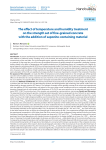
Статья научная
Introduction. To restore and develop the Solovetsky Islands road network concrete slabs could be used. Currently, compositions with additives of industrial waste, including micro- and nanoscale, are being actively introduced to improve the performance characteristics of the road slabs. For the Arkhangelsk region, saponite-containing waste from the mining industry could be used as a material. At the same time, one of the ways to accelerate the process of gaining strength of composites is steaming. However, studies related to the effect of temperature and humidity treatment on the hardening process of a composite with a highly dispersed saponite-containing material (SCM) have not been previously studied. It is known that the process of moisture sorption with a finely dispersed additive allows controlling structure formation during concrete hardening, improving its operational characteristics. However, under conditions of high humidity, the quantitative content of tempering water, calculated based on the value of water absorption of the SСM, can significantly change and affect the process of gaining the strength of the composite. Therefore, the purpose of this research is to study the effect of temperature and humidity treatment on the strength gain of fine-grained concrete with the addition of SCM. It has been established that the accelerated method of concrete hardening has only a positive effect on the formation of a strong and dense structure. However, in the case of using highly dispersed saponite-containing material as an additive, the opposite effect (decrease in strength) associated with sorption properties and features of its structure can be observed. Methods and Materials. The SCM recovered from the recycled water was dried to constant weight and dispersed on a planetary ball mill. Particle size was determined by dynamic and electrophoretic light scattering, and specific surface area was determined by nitrogen sorption (BET theory). The strength of samples of fine-grained concrete of the control and experimental (with the addition of SCM) compositions was gained in two ways: under normal conditions and by an accelerated method using steaming. Strength tests of cube samples with dimensions of 70×70×70 mm were carried out on an automatic test press according to GOST 10180. The microstructure of the samples was examined by scanning electron microscopy. Results and Discussion. The separated, dried and ground saponite-containing material (powder) had an average particle size of 445±40 nm and a specific surface area of 50 670±10 m2/kg. In continuation of the studies, control (FGC) and test samples of fine-grained concrete (FGCscm) were made. The amount of a highly dispersed additive was introduced into the concrete mixture based on previously obtained results of kinetic studies of the water absorption process of saponite-containing material. The determination of the strength characteristics of 1-FGC and 1-FGCscm, hardening under normal conditions, was carried out on day 28. Samples of 2-FGC and 2-FGCscm, a day after sealing with water, were placed in a steaming chamber. After the expiration of the holding time, they were gradually cooled and their strength characteristics were determined. It has been established that the accelerated method of gaining strength of finegrained concrete, by steaming, has a positive effect only on control samples. For a composite with the addition of SCM, temperature and humidity treatment has the opposite effect. Thus, the dynamics of strength gain of 1-FGC and 1-FGCscm are of the same type. At the initial moment of time, an active site of strength gain is observed, but on day 7, the compressive strength of the samples of the experimental composition is 40% higher than that of the control one. At the accelerated curing method in the first two hours (isothermal heating stage), an active strength increase was observed in 2-FGC and 2-FGCscm. The subsequent curing of the control specimens has a linear dependence with a gradual increase in strength to the design strength in six hours. For 2-FGCscm, after two hours of steaming, the strength sharply begins to decrease, and after six hours – visible destruction of the concrete structure occurs. Consequently, prolonged temperature and humidity exposure of concrete with highly dispersed SSM admixture leads to a decrease in the strength characteristics of the specimens. Most likely, it is connected with moisture oversaturation of the composite structure. Therefore, in continuation of the research, electronic photographs were taken of the microstructure of concrete after three hours of holding in the steaming chamber. Thus, the microstructure of 2-FGCscm is mainly represented by spongy particles, and the number of formed needle-like (tobermorite crystals) – decreased significantly, compared to the control.
Бесплатно
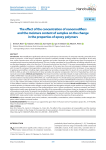
Статья научная
Introduction. Nanomodification significantly enhances the performance characteristics of composite materials, particularly those based on polymers. A wide range of materials from natural to artificially created are being studied as nanoobjects. At the same time, carbon nanostructures, such as fullerenes, graphene and carbon nanotubes, are of great interest from the perspective of comprehensively improving material performance. The use of carbon nanotubes for the modification of building materials for various functional purposes, even at low (less than 1% by mass) and ultra-low (less than 0.1% by mass) concentrations, demonstrates a remarkable capability to enhance a multitude of parameters. At the same time, there are technological challenges associated with the need for compound homogenization, requiring the use of ultrasonic processing and other techniques. A new approach to applying nanomodifiers, including single-walled graphene nanotubes, emerged after the launch of a new synthesis facility by OCSiAl in 2020, as well as the introduction of these nanotubes into polymer compounds in the form of masterbatches, which are nanotube concentrates. Methods and materials. This research involved a masterbatch based on single-walled carbon nanotubes TUBALL MATRIX M201 manufactured by OCSiAl.ru LLC. The polymers were made on the basis of low-viscosity epoxy resin Etal–247 and two hardeners manufactured by ENPTs EPITAL JSC –Etal-45M and Etal-1472. Tensile testing was performed on briquet specimens according to GOST 11262-2017. The tests involved AGS-X series bursting machine with TRAPEZIUM X software at a temperature of 23±2 °C and a relative air humidity of 50±5%. The mechanical properties (tensile and deformation) of the polymers were measured in three different moisture conditions: equilibrium-moisture, dry, and moisture-saturated. Results and discussion. The research revealed variations in ultimate tensile strength, tensile elongation and elongation at break, tensile modulus as a function of SGNT concentration and the moisture content of the studied polymers (series “without conditioning”, “moisture-saturated”, and “dried”). Mathematical models were developed to assess the effect of the nanomodifier and moisture content on changes in the properties of the polymers under study. The research has identified the optimal concentrations of the nanomodifier injected for enhancing the elastic and strength characteristics of epoxy polymers. Conclusion. The research indicates that masterbatches based on TUBALL MATRIX M201 single-walled carbon nanotubes hold potential for enhancing the properties of epoxy polymers.
Бесплатно
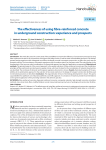
Статья научная
Introduction. The article discusses the current state of the possibilities to improve the efficiency of construction processes by using fibre-reinforced concrete in the construction of transport and utility tunnels, as well as other critical building structures. The authors present foreign experience with widespread use of fibre-reinforced concrete in transport construction, as well as few such cases for domestic practice. The inconsistency of domestic experience with the modern state of art has been noted. The main blockers in the development of the issue are under consideration, the theoretical approach and practical application are presented. Materials and methods. The principal aspects of the current approach to the quality indicators of fibre-reinforced concrete and the classification principles of fibre-reinforced concrete based on quality criteria, which are the basis for the normalization of material characteristics, are described. The continuity of domestic and European regulatory documents is shown. Results. Illustrated examples of the possibilities of an optimization approach to the selection of structural solutions in the design of transport construction facilities used in international practice are described. Conclusion. The argumentation in favor of technology development is shown. This opens up possibilities for significant cost reduction justified by a scientific approach. In conclusion, the authors provide recommendations on the general application of the promising material in the domestic practice.
Бесплатно
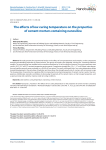
The effects of low curing temperature on the properties of cement mortars containing nanosilica
Статья научная
This study presents the experimental results on the effects of curing temperature and nanosilica, on the compressive strength and absorbing properties of cement mortars. Two groups of mortars were prepared, with the first containing reference samples. The second group was modified with a nanosilica admixture by 3% of the weight of cement. The mortar specimens were cured in 20оC, 10оC and 5оC constant temperature environments. Compressive strength after 12 h, 1, 2, 7 and 28 days, water absorption and capillary porosity were evaluated on a 40×40×40 mm prism. The results confirmed that a low curing temperature delays strength development in the early days of hydration and slows down the strength growth rate of mortars, with an increase in age. The incorporation of nanosilica has a positive effect in improving the mechanical properties of cement mortars cured at low temperatures. Additionally, nanosilica contributes to decreasing the porosity of the cement matrix, so that transport properties, such as open porosity and sorptivity, improve under all curing conditions.
Бесплатно
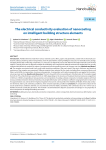
The electrical conductivity evaluation of nanocoating on intelligent building structure elements
Статья научная
Introduction. Flexible elements made from various materials such as films, papers and geotextiles, coated with an electrically conductive coating containing carbon nanoparticles, have the potential for creating intelligent structures. To rationally choose, design, and apply electrically conducting components, it is necessary to objectively assess their behavior throughout the life cycle of these objects. Currently, there are no objective methods for evaluating such components. Methods and tools are needed that can not only evaluate initial electrical conductivity values of components but also predict dynamics of changes over time. Methods and Materials. The samples were tested under cyclic multi-axial stretching conditions. After each stretch, the strain, thickness, and electrical resistance of the samples were measured. Different materials were selected for the study, including films, nonwoven fabrics, and fabrics which differ in composition, structure, and properties. A composition with carbon nanoparticles was applied to the materials using screen printing. Results and discussion. The tests showed that the irreversible part of deformation of the sample ranged from 8% to 75%, while thickness varied from 6% to 100% depending on the structure of materials. Electrical resistance ranged from 25 Ohms to 5 KOhms, depending on test parameters and composition of coating-substrate composite. Correlation analysis confirmed strong correlation between electrical resistivity and sample deformation with correlation coefficient ranging between 0.6 and 0.78. An approximation was used to derive empirical equations that can be used to predict the reliability of flexible, electrically conductive elements under cyclic stretching conditions, which simulate operating conditions. Conclusion. A comparative analysis of test results under these conditions allowed us to recommend nonwoven fabrics and fabrics with a thickness of 0.5–0.7 mm for use as flexible electrically conducting elements. This method is recommended for objective assessment of changes in the properties of these components in intelligent building structures.
Бесплатно
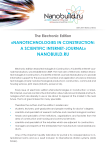
The electronic edition «NANOTECHNOLOGIES IN CONSTRUCTION: A Scientific Internet-Journal»
Другой
Бесплатно

The electronic edition «Nanotechnologies in construction: A Scientific Internet-Journal»
Другой
Бесплатно

The electronic edition «Nanotechnologies in construction: A Scientific Internet-Journal»
Другой
Бесплатно

The electronic edition «Nanotechnologies in construction: A Scientific Internet-Journal»
Другой
Бесплатно

The electronic edition «Nanotechnologies in construction: A Scientific Internet-Journal»
Другой
Бесплатно

The electronic edition «Nanotechnologies in construction: A Scientific Internet-Journal»
Другой
Бесплатно
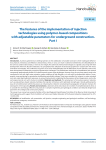
Статья научная
Introduction. A primary geotechnical challenge pertains to the stabilization of unstable soils due to their inadequate deformation, physical, mechanical, and filtration characteristics, which, in turn, can result in abnormal settlements, the destabilization of the soil mass under external loads, or even its own weight. The advent of chemical technologies on a global scale, along with their development within the Russian Federation, has precipitated the utilization of advanced equipment in conjunction with novel, innovative technologies. This confluence has given rise to novel methodologies and the fabrication of new materials, which have been instrumental in addressing a myriad of geotechnical challenges. The predominant methods of soil stabilization with mineral compounds (predominantly based on Portland cement) possess clear advantages; however, they do not always permit work to be conducted in soils with high water saturation, under conditions of high filtration, or in soils with low deformation indices. Consequently, issues pertaining to cementation stabilization periodically emerge. These issues manifest, for instance, in water-saturated rock soils under high hydrostatic pressures, in various fractured soils complicated by the presence of karst depressions, and in silty and organomineral soils with structural instability. Materials and methods. The employment of innovative polymer materials, such as polyurethane-based materials, facilitates the injection of mixtures with optimized strength gain, thereby addressing the issue of soil reinforcement within this process or enhancing the criteria for constraining the propagation of injection mixtures for subsequent cement grouting. Results and conclusion. Laboratory tests and analysis of a number of completed projects allow us to consider this technology effective and practical in complex engineering and geological conditions and beyond design-basis parameters for underground construction projects. This research was carried out using the facilities of the Head Regional Shared Research Facilities of the Moscow State University of Civil Engineering, with support from the Ministry of Science and Higher Education of the Russian Federation (Agreement No. 075- 15-2025-549)
Бесплатно

Статья научная
Introduction. A primary geotechnical challenge pertains to the stabilization of unstable soils due to their inadequate deformation, physical, mechanical, and filtration characteristics, which, in turn, can result in abnormal settlements, the destabilization of the soil mass under external loads, or even its own weight. The advent of chemical technologies on a global scale, along with their development within the Russian Federation, has precipitated the utilization of advanced equipment in conjunction with novel, innovative technologies. This confluence has given rise to novel methodologies and the fabrication of new materials, which have been instrumental in addressing a myriad of geotechnical challenges. The predominant methods of soil stabilization with mineral compounds (predominantly based on Portland cement) possess clear advantages; however, they do not always permit work to be conducted in soils with high water saturation, under conditions of high filtration, or in soils with low deformation indices. Consequently, issues pertaining to cementation stabilization periodically emerge. These issues manifest, for instance, in water-saturated rock soils under high hydrostatic pressures, in various fractured soils complicated by the presence of karst depressions, in dispersed, silty, and organo-mineral structurally unstable soils. Materials and methods. The employment of innovative polymer materials, such as polyurethane-based materials, facilitates the injection of mixtures with optimized strength gain, thereby addressing the issue of soil reinforcement within this process or enhancing the criteria for constraining the propagation of injection mixtures for subsequent cement grouting. Results and conclusion. Laboratory tests and analysis of a number of completed projects allow us to consider this technology effective and practical in complex engineering and geological conditions and beyond design-basis parameters for underground construction projects. The present study was carried out using the material and technical resources of the Main Regional Center for Collective Use of Scientific Equipment and Installations of the Moscow State University of Civil Engineering, with the support of the Ministry of Science and Higher Education of the Russian Federation (agreement No. 075-15-2025-549).
Бесплатно
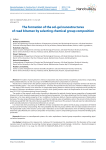
The formation of the sol-gel nanostructures of road bitumen by selecting chemical group composition
Статья научная
The studies of paving bitumen chemical composition and physicochemical properties produced by compounding deeply oxidized bitumen, tar and vacuum gas-oil of different hydrocarbon composition are carried out. The bitumen is marked to have the optimal complex of properties if the best chemical group composition of three main elements bitumen binding agents – oils, resins and asphaltenes - is formed. That provides the best structure of bitumen oildisperse system. The object of the research is the selection of compounded paving bitumen chemical group composition that provides the formation of bitumen nanodisperse system as «sol-gel» which quality metrics match the requirements of the new State Standard 33133-2014 «Petroleum paving viscous bitumen». The analysis of the research results makes it possible to determine the optimal chemical group composition of compounded bitumen that meets standard requirements by physicochemical properties. It has been determined that the higher the bitumen dispersion is, the more plastic properties it has. In addition, the bitumen ability to thermal-oxidative processes of deterioration decreases. The value range of bitumen dispersion and the most optimal values of asphaltenes ratio to the amount of oils and resins for bitumen grade BND 100/130 and for bitumen grade BND 70/100 were found. This amount of oils and resins for referred bitumen grades provide production of nanostructured bitumen as «sol-gel». It is shown that when processing tar of different chemical composition the optimal chemical group composition of finished product can be formed by compounding. That rises probability that the end product will fit to the new State Standard 33133-2014. The represented results of the research can be used in fabrication as the modern laboratories of the oil-refining enterprises can determine quite efficiently the chemical composition of oil products used in compounding processes in bitumen binding agents production.
Бесплатно
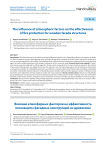
Статья научная
Introduction. The article discusses how artificial wood aging affects the retention of its fireproofing efficiency to evaluate the ability of a fire-bio-moisture-resistant impregnating agent to protect facing timber materials of facade systems exposed to weathering, such as varying temperature and humidity, if standardized levels of fire hazard and integrity are maintained and the impregnating agent has water-soluble phosphorus and nitrogen compounds of the nanoscale range. Research focus and methods. A specimen of pine wood was subjected to artificial aging for 120 days, which is equivalent to 15 years of outdoor operation. The method of pressurized impregnation was applied to pre-treat the specimen with the fireproofing agent. Climate testing was followed by a comparative evaluation of combustibility parameters according to a standard experimental method used to distribute combustible and hardly combustible materials between combustibility groups. Besides, before and after aging, all surfaces of fireproof wood specimens were subjected to thermo-analytical studies and visual inspection. Results and discussion. Results of combustibility group identification and principal thermal decomposition parameters of fireproof pine timber remained nearly the same before and after climate testing. Further comparative visual examination of surfaces of timber specimens identified no external changes. Conclusion. Research on the stability of fireproofing properties in pressure-impregnated timber shows that it can retain its effectiveness for up to 15 years under natural weathering conditions.
Бесплатно
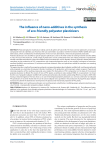
The influence of nano-additives in the synthesis of eco-friendly polyester plasticizers
Статья научная
Plasticized polymer materials are widely used in all spheres of human life. The most common plasticizers are aromatic compounds-esters of o-phthalic acid. However, their use was limited in accordance with the EU Directive REACH (2009) due to possible toxicity, which contributed to the development of new non-toxic alternatives, which include polyester plasticizers. Polyester plasticizers are classified as special purpose plasticizers. Due to the wide variety of starting materials and the ability to vary the size of the molecule, a wide range of plasticizers can be synthesized. These are mainly polyesters of polyatomic alcohols esterified with dibasic acids and modified with monocarboxylic acid or aliphatic alcohol. Polyesters-based plasticizers contribute to the production of PVC compositions with improved properties such as low volatility, resistance to extraction, excellent flexibility, wear resistance, UV resistance and heat resistance. Also, such plasticizers exhibit an excellent non-sweating property of plastics. This paper describes a method for preparing a polyester compound propylene glycol adipate modified with cyclohexanecarboxylic acid, proposed as a plasticizer of polyvinyl chloride. Conditions of its production with maximum output are given. Physical and chemical properties of the resulting compound were studied. The formulation of PVC-composition on the basis of the received polyester plasticizer is offered. The results of tests of PVC plastic according to state standard 5960-72 are presented. It is shown that the use of propylene adipate modified with cyclohexanecarboxylic acid provides a plasticizing efficiency as high as DOP, while having a reduced migration. This fact allows us to use the developed polyester plasticizer as a non-toxic alternative to industrial PVC plasticizers. It has been found that the use of calcium adipate nano quantities in the production of propylene glycol adipate increases the yield of the desired ester and improves the physical and mechanical properties of PVC plastic.
Бесплатно
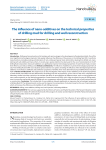
Статья научная
Introduction. Drilling and reconstruction of oil and gas wells are key stages in the development of hydrocarbon fields. One of the most significant technological elements that greatly influences the efficiency of the process is the drilling fluid (DF). It performs many functions, including cooling and lubrication of rock-cutting and special tools, bottomhole cleaning from drilled rock, maintaining well wall stability and many others. In recent years, special attention has been paid to the use of nanomaterials in the DF drilling fluid composition. Nanoscale additives can significantly improve technological properties of water-based muds, increase their efficiency and reduce drilling costs. Methods and Materials. The influence of additives on general technological parameters of Clay-Free Drilling Mud (CFDM) was evaluated. Special attention was paid to revealing the influence of the developed experimental additives on the friction coefficient and antifriction properties of (CFDM), which were determined using modified friction machine AI5018. Results and discussion. This study focuses on the investigation of the impact of nano-additives on the technical properties of water-based mud (WBs) and their effectiveness for drilling and well reconstruction. In the course of the work, comprehensive laboratory studies have been carried out to evaluate the effect of nano-additives of different nature, such as nano-graphite and nano-carbon materials, on the lubricating properties of water-based mud (WBs), which helps to reduce the wear of drilling equipment, increase the mechanical speed of drilling and, as a consequence, reduce the time and financial costs of well construction and re-construction. Conclusion. The introduction of nano-additives allowed significantly in improving the technological properties of drilling fluid DF. The obtained results can be used to improve the compositions of solutions based on the use of nanomaterials, which will increase the efficiency and reliability of well drilling processes.
Бесплатно



